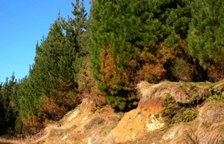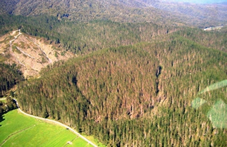PESTS AND DISEASES OF FORESTRY IN NEW ZEALAND
Physiological needle-blight
- Physiological needle blight
From Field Assessment, Control and Identification of Common Foliage Diseases of Pine in New Zealand. In this page: Diagnostic features Disease locations Primary diagnostic features of Physiological Needle Blight (PNB) Needles… - Towards an understanding of the causes of physiological needle blight in Pinus radiata
Gould N, Bulman LS, Dick MA, December 2008 (pdf)
- Episodic Defoliation (Physiological Needle Blight) of Pinus radiata
From Forest Health News No. 145, October 2004. Severe defoliation of Pinus radiata during late winter and spring has been recorded in a number of locations throughout New Zealand for… - “Strasseria” disorder of Pinus radiata
From Forest Health News No. 123, October 2002. Episodic defoliation of Pinus radiata has occurred over a number of years in Northland, East Cape, Westland and the central North Island, the most… - Physiological Needle Blight, Defoliation of Pinus radiata
From Forest Health News 102, November 2000. Incidences of severe defoliation of Pinus radiata have occurred again this spring in some locations. Symptoms can be dramatic and the cause of…

Physiological Needle Blight (PNB) is a very new disorder to many forest managers. Generally it affects trees older than 15 years, but will also be found in younger stands where it is often mistaken for Dothistroma and needlessly sprayed. The colour change can be rapid and spectacular with the red to brown-grey foliage becoming apparent as early as autumn, but peaking in the mid to late winter/early spring. Although there is some debate regarding repeated defoliation there is little doubt PNB and other disorders are a constant companion of some stands resulting in poor overall needle retention.

Dothistroma is a well-known needle blight more prevalent in the younger classes with trees building an increased resistance to severe infection from about 15 years in age. The assessment and treatment options for Dothistroma are well documented, but generally if the trees in a stand have around 15% of their green crown infected at the time of assessment in June-August, some level of spraying with copper fungicide should occur in the early summer.
Cyclaneusma is a very common fungal needle cast mostly seen in Spring and Autumn causing yellowing and sometimes red foliage to trees older than 12 yrs, however severe a-typical expression of this disease has been noted on much younger trees at other times of the year. The most recent year’s foliage is not affected as infection occurs a year before symptoms become apparent. No treatment is economically viable.

 Farm Forestry New Zealand
Farm Forestry New Zealand

